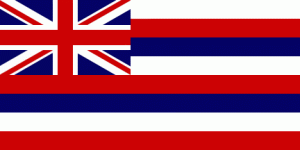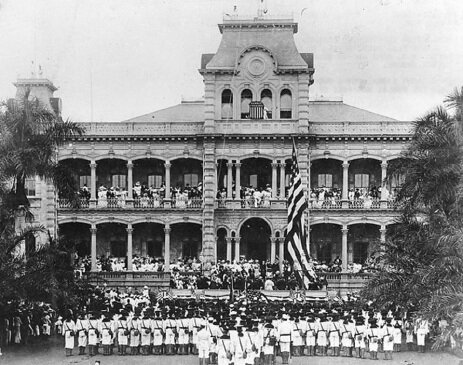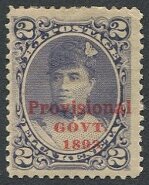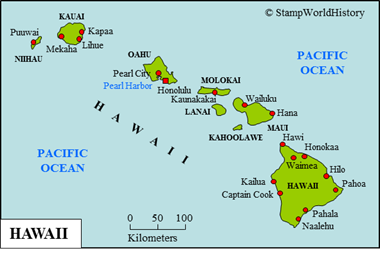
Hawaii
Quick reference
General issues: Kingdom 1851-1893, Provisional government 1893-1894, Republic 1894-1898, United States administration 1898-1900
Country name on general issues: Hawaiian Postage, H.I. Postage, Hawaii
Currency: 1 Dollar = 100 Cents 1851-1900
Population: 154 000 in 1900
Political history Hawaii
The road to the kingdom of Hawaii
Hawaii is an island country located in the Pacific Ocean as part of Polynesia. Opinions about the origins of the indigenous population differ – some suggest they settled Hawaii from the Marquesas Islands in the 3rd century AD while others suggest settlement from Tahiti in the 11th century AD. The Spanish may have been the first Europeans to explore Hawaii in the 16th century – it lay on, or close, to their trade routes from Mexico to the Philippines. The first documented European visit to Hawaii was the landing of James Cook on the islands in 1778. At the time, the individual islands were ruled by separate chiefs. The kingdom of Hawaii was established in 1795 and expanded to include all Hawaiian islands in 1810. The first king of Hawaii was Kamehameha I. The House of Kamehameha ruled Hawaii until 1872 and was succeeded by elected kings until 1893.
The road to United States statehood
After the visit of James Cook, European missionaries, traders and whalers settled in Hawaii in the 18th century. In the 19th century American missionaries, traders and planters followed suit and in the course of the 19th century American influence rapidly increased. A white American-European elite was formed that gained more and more control 0ver politics and economic life at the expense of the monarchy. In 1887, under pressure of this elite, King Kalakaua was forced to sign a constitution that greatly reduced his power and eventually his successor, Queen Liliuokalani, was deposed in 1893. A provisional government was established that appealed for annexation of Hawaii by the United States. The United States, in 1893, shortly established a protectorate over Hawaii, but refused annexation. Subsequently, the republic of Hawaii was established in 1894. In 1898, the tables turned when a new president was elected in the United States and Hawaii had gained strategic importance as a consequence of the Spanish-American war – a war that had started in the Caribbean but had spread to the Pacific. Thus, Hawaii was annexed by the United States in 1898. Hawaii became a United States territory in 1900 and gained statehood in 1959 as the 50th state of the United States.
Economic developments

Ceremony at the occasion of the annexation of Hawaii by the United States in 1898.
Economically, Hawaii was long dependent on small scale agriculture and fishing. Europeans brought whaling to Hawaii in the early 19th century, which would be the dominant sector until forbidden in the second part of the 19th century. From the mid 19th century, Americans were leading in the development of plantations growing sugar cane and pineapple – the plantations would be the mainstay of the economy until the mid 20th century. From the late 19th century, the military presence of the United States in Hawaii also became a major contributor to the economy. In 1887, Pearl Harbor was established as an American naval base. Pearl Harbor would subsequently develop as the main United States naval base in the Pacific. In 1941, about 500 000 military personal were stationed in Hawaii – about the same as the Hawaiian population of the time. The Japanese attack on Pearl Harbor in 1941 brought the United States into WWII. In modern day Hawaii, tourism is the most important sector of the economy.
Demography
The population of Hawaii changed drastically in the 19th century. Europeans and Americans settled on the islands. To man the labor intensive plantations, developed in the 19th century, workers from different countries in Asia came to Hawaii. In modern day Hawaii, indigenous Hawaiians account for only 7% of the population. People of European and American descent account for 24% of the population and the majority of the population is of Asian descent – 41%.
Postal history Hawaii

1893 – Issued by the provisional government – the portrait is that of Queen Liliuokalani, the last reigning monarch of Hawaii.
The first stamps were issued by Hawaii in 1851 – stamps of simple local design and print showing the denomination in a frame. This first issue was meant for mail to the United States after a regular mail service had been established between Hawaii and San Francisco in 1849. As they are found mainly on mail from missionaries, they are known as the ‘Hawaiian Missionaries’. The stamps from this first issue are rare and have catalog values in the very high range. More issues of local design and print were issued in 1859 and 1865 for inter island mail. Further issues of Hawaii were printed in the United States – from 1871 by the American Bank Note Co. in New York. The designs show – almost exclusively – portraits of members of the royal family. In 1893, the provisional government issued available stamps with the overprint ‘Provisional Government’. The republican government issued a set of stamps in 1894 – inscribed ‘Hawaii’. An additional value was issued the same year – now inscribed ‘Republic of Hawaii’. The last stamps for Hawaii were issued in 1899 under United States administration. The stamps of Hawaii were superseded by those of the United States in 1900.
Album pages
← Previous page: HaitiNext page: Honduras →


